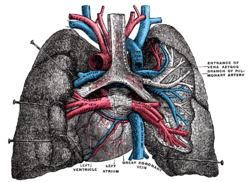Right pulmonary artery
| Right pulmonary artery | |
|---|---|
 Pulmonary vessels, seen in a dorsal view of the heart and lungs. The lungs have been pulled away from the median line, and a part of the right lung has been cut away to display the air-ducts and bloodvessels. | |
 Transverse section of thorax, showing relations of pulmonary artery. | |
| Details | |
| Source | pulmonary artery |
| Identifiers | |
| Latin | arteria pulmonalis dextra |
| TA98 | A12.2.01.101 |
| TA2 | 4077 |
| FMA | 50872 |
| Anatomical terminology | |
The right pulmonary artery or right branch of the pulmonary artery, longer and larger than the left, carries deoxygenated blood from the heart to the right lung, so that this blood can be oxygenated within the right lung. Unlike almost all other arteries, the right pulmonary artery carries deoxygenated blood. The pulmonary trunk exits the right ventricle of the heart, dividing into the left and right pulmonary arteries. The right pulmonary artery runs horizontally away from the heart and to the right, toward the right lung. The aortic arch arches over the right pulmonary artery, so that the right pulmonary artery passes underneath the aortic arch, behind the ascending aorta and in front of the descending aorta. It continues to the right, running behind the superior vena cava and in front of the right bronchus. It delivers deoxygenated blood to the root of the right lung, where it divides into two branches. The lower and larger of these goes to the middle and inferior lobes of the lung; the upper and smaller is distributed to the superior lobe.
References
![]() This article incorporates text in the public domain from page 545 of the 20th edition of Gray's Anatomy (1918)
This article incorporates text in the public domain from page 545 of the 20th edition of Gray's Anatomy (1918)
